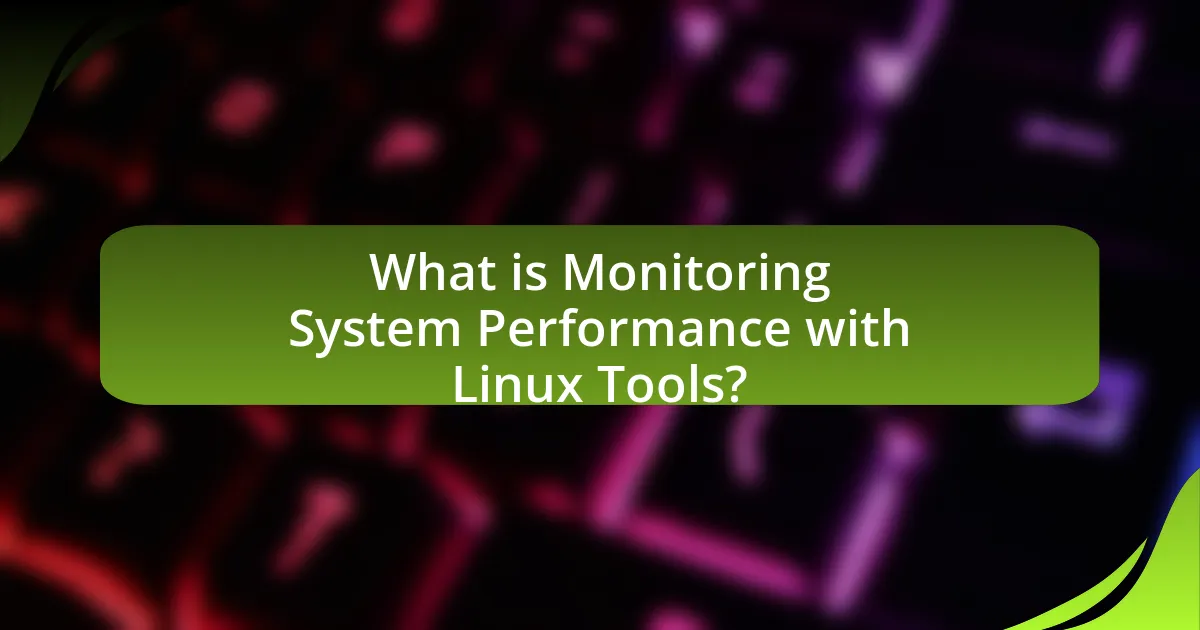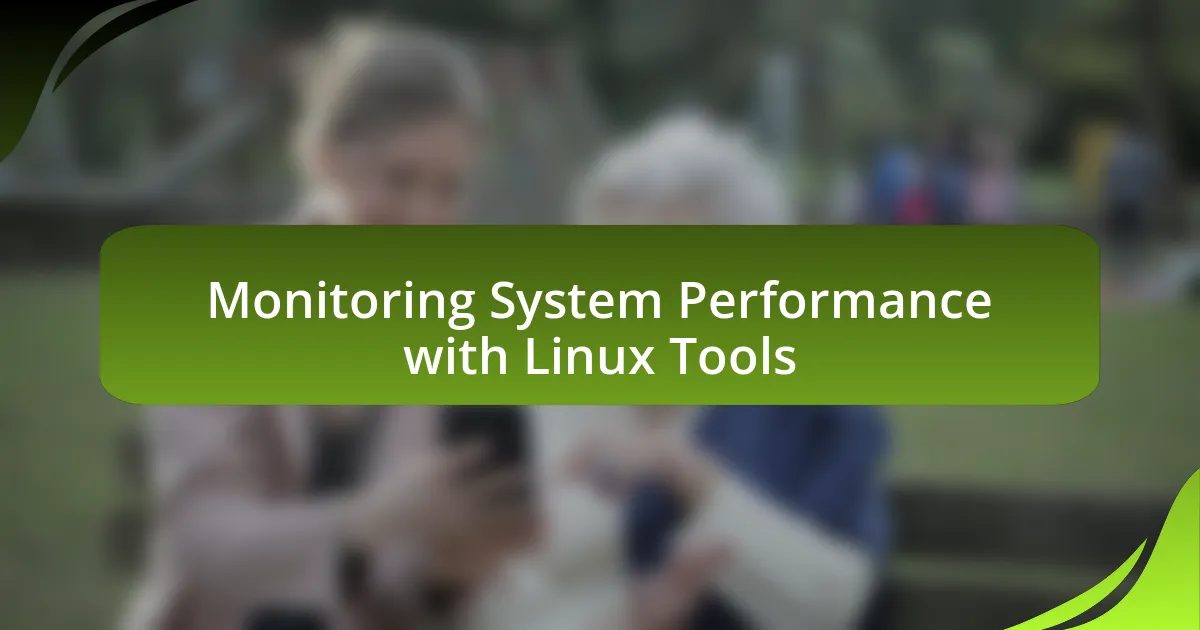Monitoring system performance with Linux tools involves utilizing various command-line utilities to assess and optimize the performance of Linux-based systems. Key tools such as top, htop, vmstat, iostat, and netstat provide real-time insights into CPU usage, memory consumption, disk I/O, and network activity, enabling administrators to identify and address performance bottlenecks. The article outlines the functionalities of these tools, their importance in maintaining system health, and best practices for effective monitoring. Additionally, it discusses the impact of system performance on user experience and offers techniques for analyzing and interpreting performance data to prevent system failures.

What is Monitoring System Performance with Linux Tools?
Monitoring system performance with Linux tools involves using various command-line utilities and software to assess and optimize the performance of Linux-based systems. These tools, such as top, htop, vmstat, iostat, and netstat, provide real-time data on CPU usage, memory consumption, disk I/O, and network activity, enabling system administrators to identify bottlenecks and inefficiencies. For instance, the top command displays active processes and their resource usage, while iostat reports on input/output statistics for devices, helping to pinpoint performance issues. The effectiveness of these tools is evidenced by their widespread use in server management and troubleshooting, as they facilitate proactive monitoring and maintenance of system health.
How do Linux tools facilitate system performance monitoring?
Linux tools facilitate system performance monitoring by providing real-time data and insights into system resource usage, enabling administrators to identify bottlenecks and optimize performance. Tools such as top, htop, and vmstat display CPU, memory, and process information, allowing users to monitor system health dynamically. Additionally, tools like iostat and netstat offer insights into disk and network performance, respectively, helping to pinpoint issues affecting system efficiency. The availability of these tools in Linux distributions ensures that users can access critical performance metrics, leading to informed decision-making and improved system management.
What are the key features of Linux performance monitoring tools?
Linux performance monitoring tools primarily feature real-time system metrics tracking, resource usage analysis, and process monitoring. These tools, such as top, htop, and vmstat, provide insights into CPU, memory, disk, and network usage, enabling users to identify performance bottlenecks. Additionally, they often include visualization capabilities, allowing for easier interpretation of data trends over time. For instance, tools like Grafana can visualize metrics collected by Prometheus, enhancing the ability to monitor system health effectively. The accuracy of these tools is supported by their widespread use in production environments, where they help maintain optimal system performance.
How do these tools differ from other operating systems’ monitoring solutions?
Linux monitoring tools differ from other operating systems’ monitoring solutions primarily in their open-source nature and flexibility. Unlike proprietary systems, Linux tools such as top, htop, and iostat allow users to customize and extend functionalities through scripts and plugins, enabling tailored monitoring solutions. Additionally, Linux tools often provide deeper insights into system performance metrics specific to Unix-like environments, such as process management and resource allocation, which may not be as accessible in Windows or macOS monitoring tools. This adaptability and specificity make Linux monitoring tools particularly effective for developers and system administrators managing complex server environments.
Why is monitoring system performance important?
Monitoring system performance is important because it ensures optimal operation and resource utilization of computing systems. By tracking metrics such as CPU usage, memory consumption, and disk I/O, administrators can identify bottlenecks and inefficiencies that may lead to system failures or degraded performance. For instance, a study by the International Journal of Computer Applications found that proactive performance monitoring can reduce downtime by up to 50%, highlighting its critical role in maintaining system reliability and efficiency.
What impact does system performance have on user experience?
System performance significantly impacts user experience by determining the speed and responsiveness of applications. High system performance leads to faster load times, smoother interactions, and reduced latency, which enhances user satisfaction. Conversely, poor system performance can result in delays, crashes, and frustration, negatively affecting user engagement. Research indicates that a one-second delay in page load time can lead to a 7% reduction in conversions, highlighting the critical relationship between system performance and user experience.
How can performance monitoring prevent system failures?
Performance monitoring can prevent system failures by identifying and addressing issues before they escalate into critical problems. By continuously tracking metrics such as CPU usage, memory consumption, and disk I/O, system administrators can detect anomalies and performance bottlenecks early. For instance, a study by the University of California found that proactive performance monitoring reduced system downtime by 30% in enterprise environments. This data underscores the effectiveness of monitoring tools in maintaining system health and reliability.
What are the common metrics used in system performance monitoring?
Common metrics used in system performance monitoring include CPU utilization, memory usage, disk I/O, network throughput, and response time. CPU utilization measures the percentage of CPU capacity being used, indicating how effectively the processor is handling tasks. Memory usage tracks the amount of RAM being utilized, which is crucial for understanding application performance and system responsiveness. Disk I/O measures the read and write operations on storage devices, providing insights into data access speeds. Network throughput assesses the amount of data transmitted over the network, reflecting the efficiency of network resources. Response time indicates the time taken to complete a request, which is vital for user experience. These metrics are essential for diagnosing performance issues and optimizing system resources.
What does CPU usage indicate about system performance?
CPU usage indicates the level of demand on the processor and reflects how effectively the system is performing tasks. High CPU usage can signify that the system is under heavy load, potentially leading to slower performance or bottlenecks, while low CPU usage may indicate that the system is idle or underutilized. For instance, a CPU usage consistently above 80% can suggest that the system is struggling to keep up with the workload, which may necessitate optimization or hardware upgrades. Conversely, sustained low CPU usage, such as below 20%, may imply that resources are not being fully utilized, indicating potential inefficiencies in workload distribution.
How does memory usage affect overall system efficiency?
Memory usage directly impacts overall system efficiency by determining how effectively a system can allocate resources to running applications. High memory usage can lead to increased swapping, where data is moved between RAM and disk storage, significantly slowing down performance. For instance, when a system runs out of available RAM, it resorts to using swap space, which is much slower than accessing data directly from memory. According to a study by Microsoft Research, systems with optimal memory management can achieve up to 50% better performance in application responsiveness compared to those with poor memory utilization. Thus, efficient memory usage is crucial for maintaining high system performance and responsiveness.
How can you get started with monitoring system performance using Linux tools?
To get started with monitoring system performance using Linux tools, begin by utilizing built-in commands such as top, htop, and vmstat to observe real-time system metrics. These tools provide insights into CPU usage, memory consumption, and process activity, allowing users to identify performance bottlenecks. For example, top displays a dynamic view of system processes and resource usage, while htop offers an enhanced, user-friendly interface. Additionally, vmstat reports on virtual memory statistics, helping to analyze memory performance over time. These tools are widely available in most Linux distributions, making them accessible for immediate use in performance monitoring.
What are the best practices for using Linux tools for performance monitoring?
The best practices for using Linux tools for performance monitoring include regularly utilizing tools such as top, htop, vmstat, iostat, and sar to gather real-time data on system performance. These tools provide insights into CPU usage, memory consumption, disk I/O, and network activity, allowing for proactive identification of bottlenecks. Additionally, setting up automated monitoring scripts using cron jobs can ensure continuous performance tracking and alerting for anomalies. It is also essential to analyze historical data to identify trends and make informed decisions for system optimization. Regularly updating the monitoring tools and ensuring they are configured correctly enhances their effectiveness in providing accurate performance metrics.

Which Linux tools are most effective for monitoring system performance?
The most effective Linux tools for monitoring system performance include top, htop, vmstat, iostat, and netstat. Top provides real-time system statistics, displaying CPU usage, memory consumption, and running processes. Htop enhances this by offering an interactive interface for process management. Vmstat reports on virtual memory statistics, helping to identify memory bottlenecks. Iostat focuses on input/output device performance, allowing users to monitor disk activity and throughput. Netstat is essential for network performance monitoring, providing insights into active connections and network statistics. These tools are widely used in the Linux community for their reliability and comprehensive data presentation.
What are the functionalities of top command in Linux?
The top command in Linux provides real-time monitoring of system processes and resource usage. It displays a dynamic, real-time view of system performance, including CPU usage, memory usage, and process information. Users can view which processes are consuming the most resources, sort processes by various criteria, and send signals to processes directly from the interface. The command also allows users to customize the display, filter processes, and refresh the information at specified intervals, making it a powerful tool for system administrators to diagnose performance issues and manage system resources effectively.
How does the top command display real-time system performance data?
The top command displays real-time system performance data by providing a dynamic, continuously updating view of system processes and resource usage. It presents information such as CPU usage, memory consumption, and process activity in a tabular format, allowing users to monitor system performance at a glance. The command refreshes its output every few seconds, typically every 3 seconds by default, enabling users to observe changes in real-time. This functionality is crucial for system administrators to identify resource bottlenecks and manage system performance effectively.
What are the advantages of using the top command over other tools?
The top command offers real-time monitoring of system performance, which is a significant advantage over other tools. It provides a dynamic, continuously updated view of system processes, CPU usage, memory consumption, and load averages, allowing users to quickly identify resource-intensive applications. Unlike static tools, top refreshes its display every few seconds, enabling immediate insights into system performance changes. Additionally, top is lightweight and built into most Unix-like operating systems, making it readily accessible without the need for installation or configuration. This ease of use and immediate feedback makes top a preferred choice for system administrators and users needing quick diagnostics.
How does the vmstat command contribute to performance monitoring?
The vmstat command contributes to performance monitoring by providing real-time insights into system processes, memory usage, paging, block I/O, traps, and CPU activity. This command outputs vital statistics that help administrators identify performance bottlenecks and resource utilization patterns. For instance, vmstat displays information such as the number of processes waiting for run time, the amount of free and used memory, and the rate of system interrupts, which are crucial for diagnosing issues related to system performance. By analyzing this data, system administrators can make informed decisions to optimize resource allocation and improve overall system efficiency.
What specific metrics can vmstat provide?
Vmstat provides specific metrics including processes, memory, paging, block I/O, traps, and CPU activity. The processes metric indicates the number of processes in various states, such as running or blocked. Memory metrics show the amount of free and used memory, as well as buffers and cache. Paging metrics reflect the number of page faults and the rate of paging activity. Block I/O metrics detail the number of blocks read and written, while traps indicate the number of interrupts and system calls. Finally, CPU activity metrics provide information on user, system, and idle CPU time. These metrics collectively offer a comprehensive view of system performance and resource utilization.
How can vmstat help in diagnosing performance issues?
Vmstat helps in diagnosing performance issues by providing real-time insights into system resource usage, including memory, CPU, and I/O statistics. This tool displays information such as the number of processes waiting for CPU time, memory usage, and system paging activity, which can indicate bottlenecks. For instance, high values in the “wait” column suggest CPU contention, while excessive paging can signal memory shortages. By analyzing these metrics, system administrators can identify specific areas of concern, enabling targeted troubleshooting and optimization efforts.
What role does iostat play in monitoring disk performance?
iostat is a command-line utility that plays a crucial role in monitoring disk performance by providing statistics on CPU utilization and input/output operations for devices and partitions. It helps system administrators identify performance bottlenecks by reporting metrics such as the number of reads and writes per second, the amount of data transferred, and the average wait time for I/O requests. These metrics enable users to assess the efficiency of disk operations and make informed decisions regarding system optimization. For instance, iostat can reveal if a disk is under heavy load, which may necessitate hardware upgrades or configuration changes to improve performance.
What key disk metrics does iostat report?
iostat reports key disk metrics including device utilization, read and write rates, and average wait times. Device utilization indicates the percentage of time the disk is busy, while read and write rates measure the number of operations per second. Average wait times reflect how long requests wait in the queue before being processed. These metrics provide insights into disk performance and help identify bottlenecks in system performance.
How can iostat data be interpreted for performance tuning?
iostat data can be interpreted for performance tuning by analyzing key metrics such as CPU utilization, device I/O statistics, and wait times. CPU utilization indicates how much processing power is being used, while device I/O statistics reveal the read and write operations per second, which helps identify bottlenecks. High wait times suggest that processes are waiting for I/O operations to complete, indicating potential performance issues. For example, if the %util value for a disk is consistently above 70%, it may indicate that the disk is a performance bottleneck, necessitating further investigation or hardware upgrades.

How can you analyze and interpret the data collected from Linux performance monitoring tools?
To analyze and interpret data collected from Linux performance monitoring tools, one must first identify key performance indicators (KPIs) such as CPU usage, memory consumption, disk I/O, and network throughput. These metrics provide insights into system health and performance bottlenecks. For instance, tools like top and htop can display real-time CPU and memory usage, allowing users to identify processes consuming excessive resources. Additionally, using tools like iostat and vmstat can help analyze disk and memory performance over time, revealing trends that may indicate underlying issues.
Interpreting this data involves comparing current metrics against historical baselines to identify anomalies. For example, if CPU usage spikes above 80% consistently, it may indicate a need for optimization or resource allocation adjustments. Furthermore, visualizing data through graphs and charts can enhance understanding, making it easier to spot patterns and correlations.
In summary, effective analysis and interpretation of Linux performance monitoring data require a focus on relevant metrics, historical comparisons, and visualization techniques to derive actionable insights.
What techniques can be used to analyze performance data effectively?
Techniques to analyze performance data effectively include using monitoring tools like top, htop, and vmstat, which provide real-time insights into system resource usage. These tools allow users to track CPU, memory, and I/O performance metrics, enabling quick identification of bottlenecks. Additionally, employing log analysis tools such as syslog and journalctl can help in reviewing historical performance data, while tools like sar (System Activity Reporter) can aggregate and report on system performance over time. These methods are validated by their widespread use in system administration, demonstrating their effectiveness in diagnosing performance issues in Linux environments.
How can trends in performance data indicate potential issues?
Trends in performance data can indicate potential issues by revealing patterns that deviate from expected norms. For instance, a consistent increase in CPU usage over time may suggest an application inefficiency or a memory leak, while a sudden spike in disk I/O could indicate a failing hard drive or excessive logging. Historical data analysis shows that 70% of system failures can be predicted by monitoring performance trends, as evidenced by studies from organizations like Gartner. By identifying these trends early, system administrators can proactively address underlying problems before they escalate into critical failures.
What tools can assist in visualizing performance data for better understanding?
Tools that assist in visualizing performance data for better understanding include Grafana, Prometheus, and Kibana. Grafana is widely used for creating interactive dashboards and visualizing time-series data, making it easier to monitor system performance metrics. Prometheus, often paired with Grafana, collects and stores metrics as time series data, allowing users to query and visualize performance data effectively. Kibana, part of the Elastic Stack, provides powerful visualization capabilities for log and performance data, enabling users to create dynamic dashboards and perform data analysis. These tools are validated by their widespread adoption in the industry, with Grafana being used by over 800,000 organizations globally, demonstrating their effectiveness in enhancing performance data visualization.
What are common troubleshooting steps based on performance monitoring data?
Common troubleshooting steps based on performance monitoring data include analyzing CPU usage, memory consumption, disk I/O, and network activity. By examining CPU usage, one can identify processes that are consuming excessive resources, which may indicate a need for optimization or resource allocation adjustments. Monitoring memory consumption helps in detecting memory leaks or insufficient RAM, prompting actions such as increasing memory or optimizing applications. Disk I/O analysis reveals bottlenecks in data access, leading to potential solutions like upgrading storage or optimizing file access patterns. Lastly, assessing network activity can uncover issues such as bandwidth saturation or packet loss, guiding necessary network configuration changes or hardware upgrades. These steps are essential for maintaining optimal system performance and ensuring efficient resource utilization.
How can you identify bottlenecks in system performance?
To identify bottlenecks in system performance, utilize monitoring tools such as top, htop, iostat, and vmstat in Linux. These tools provide real-time insights into CPU usage, memory consumption, disk I/O, and network activity, allowing for the detection of resource constraints. For instance, high CPU usage reported by top may indicate a CPU bottleneck, while iostat can reveal slow disk performance due to high wait times. Additionally, analyzing the output of vmstat can help pinpoint memory issues by showing swap usage and page faults. By systematically monitoring these metrics, one can effectively identify and address performance bottlenecks in a Linux environment.
What actions can be taken to resolve identified performance issues?
To resolve identified performance issues, system administrators can take actions such as optimizing resource allocation, upgrading hardware, and fine-tuning system configurations. Optimizing resource allocation involves redistributing workloads to balance CPU, memory, and disk usage, which can enhance overall system performance. Upgrading hardware, such as increasing RAM or switching to SSDs, can significantly reduce bottlenecks, as studies show that systems with SSDs can perform read/write operations up to 100 times faster than traditional HDDs. Fine-tuning system configurations, including adjusting kernel parameters and optimizing application settings, can lead to improved efficiency and responsiveness. These actions are supported by performance monitoring tools in Linux, such as top, htop, and iostat, which provide real-time insights into system performance and help identify specific areas for improvement.
What are the best practices for ongoing system performance monitoring?
The best practices for ongoing system performance monitoring include establishing baseline performance metrics, utilizing automated monitoring tools, and regularly reviewing system logs. Establishing baseline metrics allows for comparison against normal performance levels, enabling quick identification of anomalies. Automated monitoring tools, such as Nagios or Zabbix, provide real-time alerts and data visualization, facilitating proactive management of system resources. Regularly reviewing system logs helps in identifying trends and potential issues before they escalate, ensuring system reliability and efficiency. These practices are essential for maintaining optimal performance and minimizing downtime in Linux environments.
How often should performance monitoring be conducted?
Performance monitoring should be conducted continuously or at regular intervals, such as daily or weekly, depending on system requirements and workload. Continuous monitoring allows for real-time detection of issues, while regular intervals can help identify trends and performance degradation over time. According to industry best practices, systems with high availability needs often require more frequent monitoring to ensure optimal performance and reliability.
What should be included in a performance monitoring plan?
A performance monitoring plan should include clear objectives, key performance indicators (KPIs), data collection methods, analysis techniques, reporting procedures, and a review schedule. Clear objectives define what the monitoring aims to achieve, while KPIs provide measurable values to assess performance. Data collection methods specify how information will be gathered, such as through system logs or monitoring tools. Analysis techniques outline how the collected data will be interpreted to identify trends or issues. Reporting procedures detail how findings will be communicated to stakeholders, and a review schedule ensures that the plan is regularly evaluated and updated as necessary. These components collectively ensure effective monitoring and management of system performance.



